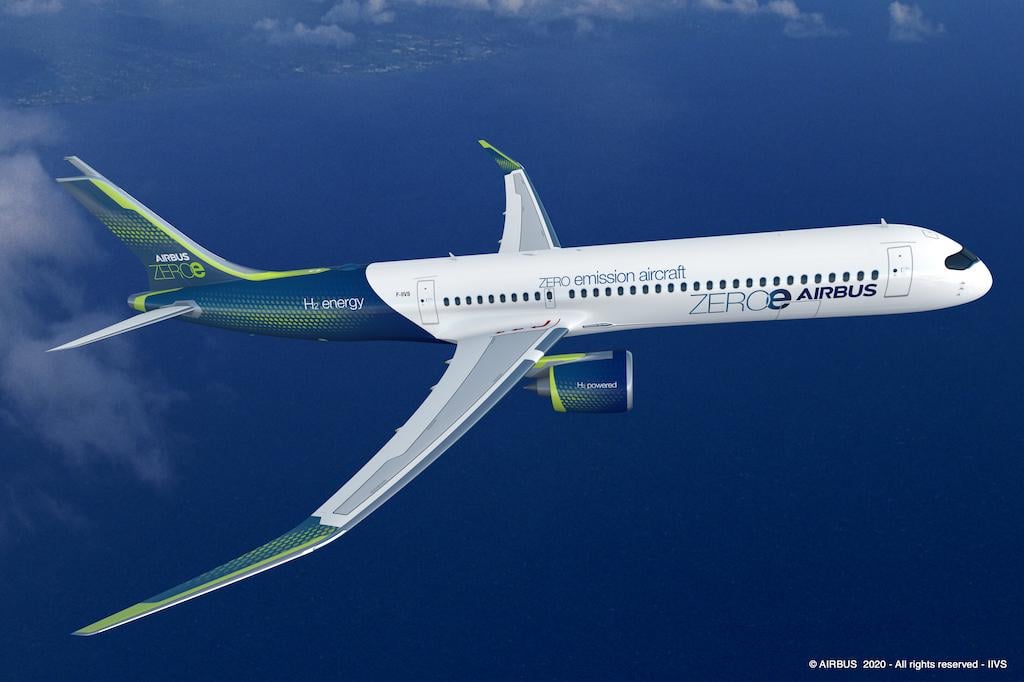
Airbus is narrowing in on three concept studies for liquid-hydrogen-powered aircraft as it tries to define a next-generation commercial aircraft to enter service in 2035. The three concepts include a regional turboprop, a narrowbody in the A320neo-family size category and a blended wing body (BWB).
“Hydrogen is one of the most promising technologies,” Airbus CEO Guillaume Faury said. “It has a lot of potential.”
In its preliminary studies, Airbus has come to the conclusion that of the various options, liquid hydrogen combustion is the most realistic technology path in the manufacturer’s efforts to produce what it hopes will effectively be a carbon-neutral aircraft. “We don’t need to invest in technologies that are completely disruptive,” he said.
Airbus, like all aircraft manufacturers and the civil aviation industry as a whole, is under enormous political pressure to reduce its environmental impact after it recovers from the coronavirus pandemic. The European aircraft-maker can benefit from massive government funding in hydrogen research both in France and Germany—state budget allocations that are intended to keep forced redundancies at Airbus and other aerospace companies to a minimum while also accelerating aviation’s transition to a greener future. The French government in particular has made clear that it expects a hydrogen aircraft, for which it has provided research funding, to enter service by 2035.
“A lot of investment is needed, and we have to be fast,” Faury said. “But we are very convinced.”
Airbus’ timeline foresees five years (until 2025) to mature technologies and more closely define which of the three avenues it will pursue further for the 2035 aircraft. “It is fair to assume that we will start small and go up in size over time,” Faury said. But he does not rule out that the first aircraft could be a narrowbody or that the narrowbody could be developed in parallel with the turboprop—noting that Airbus worked on the A350 and the A380 simultaneously.
Faury foresees the formal industrial launch in 2027 or 2028, preceded by two years of work to set up an industrial concept, negotiating with partners and suppliers as well as work on the business case. Airbus is allocating around seven years for the actual development phase, similar to conventional aircraft.
The liquid-hydrogen-powered narrowbody would likely have the most transformative effect on civil aviation. Airbus is looking at a family of aircraft with 120-200 seats and a range of 2,000 nm or more. The aircraft would be somewhat smaller than the current A320neo family, which ranges from around 130 to more than 240 seats, depending on the configuration of the A319neo, A320neo and A321neo.
The narrowbody concept is planned to be designed for a Mach 0.78 cruise speed, and its liquid hydrogen combustion would be complemented by a hybrid-electric system powered by fuel cells. A conventional tube-and-wing lay-out is the target, although the fuselage would be significantly longer to accommodate large hydrogen tanks in the rear.
A range of 2,000 nm or somewhat more is significantly shorter than that of the A320neo (3,400 nm), but it would be enough to cover all of Europe. A range well in excess of 2,000 nm would be needed for U.S. transcontinental services.
Faury is leaving open for now whether the hydrogen aircraft will be the only successor to the current A320neo family or whether another more conventional design—using synthetic fuels to reduce its environmental footprint—might complement or precede it. “Two things could be combined or could be independent in terms of timing or solution,” he said.
The A320neo will have been in service for almost 20 years by 2035; its first delivery came in 2016.
Faury concedes there are major challenges to making the new-technology aircraft a reality. Massive investment in ground infrastructure would be required to ensure that “decarbonized hydrogen is available at airports,” he said. Aviation will also need “a regulatory framework that is very different from today’s, and we will have to have clarity in 2027 or 2028,” he pointed out.
Accommodating liquid hydrogen tanks on the aircraft is a challenge manufacturers, including Airbus, have been studying for decades. The size and weight of liquid hydrogen tanks differ from kerosene tanks, and storing liquid hydrogen safely is a crucial hurdle. Faury made clear that “the level of safety has to be comparable to today’s aircraft.”
But Airbus’ biggest challenge may well be convincing industry partners that it is time for the jump to new propulsion technology, even though it might require limited changes to current engines. Sources in the engine industry are not sharing Airbus’ enthusiasm, yet their participation is imperative for the project to succeed.
And Airbus does not claim hydrogen is a solution for all segments, not even for decades. Synthetic fuels are “a low-risk solution at an affordable cost for long-haul flying,” Faury said. He did admit that the rise of hydrogen could have an impact on the already difficult business case for synthetic fuels, which are far from being available in anything near industrial quantities. Yet the two concepts could serve different applications, he said, noting that where they don’t, “competition is healthy.”





Comments
Funny how Airbus suddenly is all into Hydrogen now that the European Nation drivers have decided its now the way to go. Call it going along with the flow.
Economics say Hydrogen is going to cost a lot more than Jet Fuel efficiency wise (the aircraft is less economical) on top of its all new infrastructure for production , distribution and ops.
How about making Jet A as clean as possible and putting the money on Hydrogen into vehicles? That might work though you face either a very high pressure tank or you have to keep the Hydrogen very very cold (which for an aircraft means more systems and weight just to have Hydrogen possible when Jet A cleaned up is a drop in.)